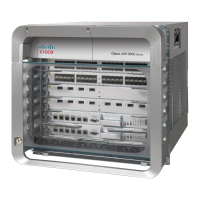67
Cisco ASR 9000 Series Aggregation Services Router Getting Started Guide
OL-28417-02
Chapter Configuring General Router Features
Displaying the Available Management Ethernet Interfaces
DETAILED STEPS
Command or Action Purpose
Step 1
configure
Example:
RP/0//CPU0:router# configure
Enters global configuration mode.
Step 2
interface MgmtEthrack/slot/CPU0/port
Example:
RP/0//CPU0:router(config)# interface //CPU0/
Enters interface configuration mode and specifies the
Management Ethernet interface of the primary .
Step 3
ipv4 address ipv4-address subnet-mask
Example:
RP/0//CPU0:(config-if)# ipv4 address .1.1.1
255...
Assigns an IP address and subnet mask to the interface.
Step 4
no shutdown
Example:
RP/0//CPU0:router(config-if)# no shutdown
Step 5
exit
Exits the Management Ethernet interface configuration
mode.
Step 6
router static address-family ipv4 unicast
0.0.0.0/0 default-gateway
Example:
RP/0//CPU0:router (config)# router static
address-family ipv4 unicast 0.0.0.0/0 12.25.0.1
Step 7
commit
Example:
RP/0//CPU0:(config)# commit
Commits the target configuration to the running
configuration.

